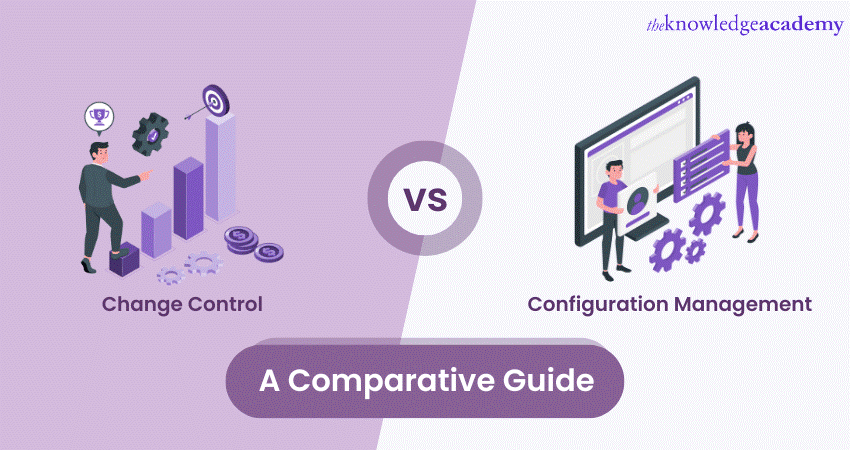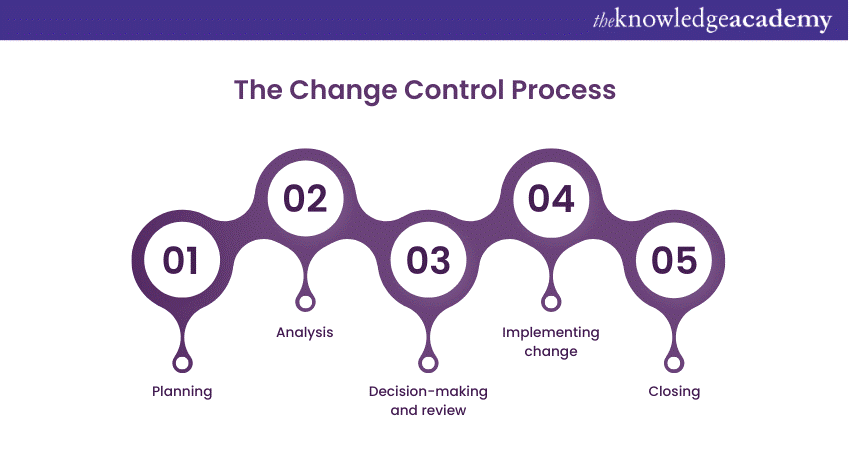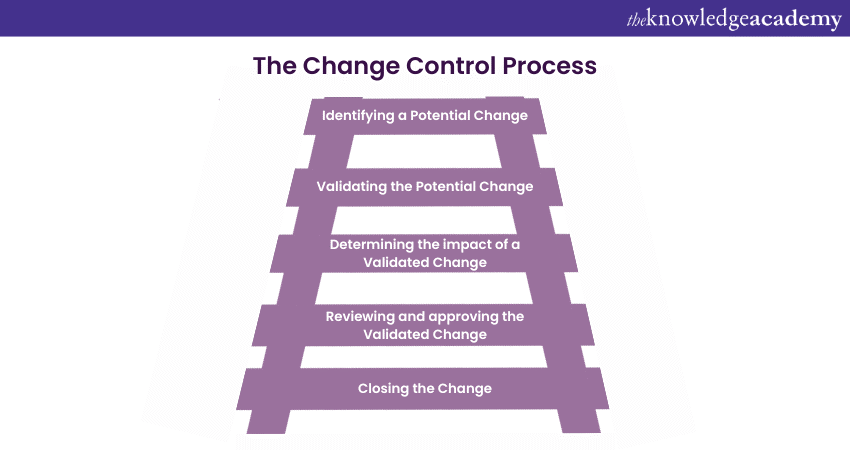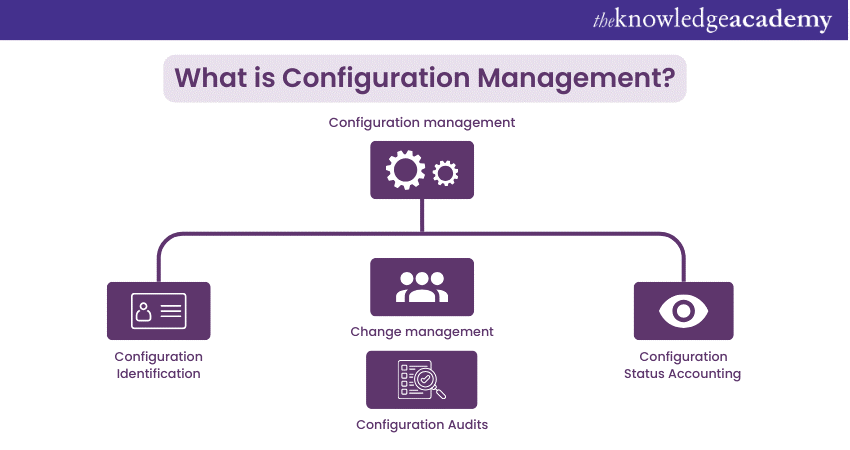We may not have the course you’re looking for. If you enquire or give us a call on + 1-866 272 8822 and speak to our training experts, we may still be able to help with your training requirements.
Training Outcomes Within Your Budget!
We ensure quality, budget-alignment, and timely delivery by our expert instructors.

Change Control and Configuration Management are two very closely related organizational practices. In order to have an in-depth understanding of Change Control vs Configuration Management, we need to understand both concepts in detail.
According to GlobeNewswire, the Change and Configuration Management market is expected to grow at a CAGR of 8.26% to £ 2.15 billion by 2028. Consumers' evolving preferences make businesses focus on Change and Configuration Management, utilizing change management tools to keep the product more relatable and customer-centric. In this blog, you will learn the critical difference in Change Control vs Configuration Management, focusing on their importance in an organisation.
Table of Contents
1) What is Change Control?
2) What is Configuration Management?
3) Change Control vs Configuration Management
a) Focus and scope
b) Objectives
c) Components
d) Application
4) Conclusion
What is Change Control?

Every business needs to improve and iterate its product or service based on the forever-changing preferences of customers. While making the change in a project, organisations need to ensure that the modifications fulfil the objectives of the suggested change.
Change Control process includes crucial steps like identifying, documenting, approving or disapproving and controlling the change in the approved project plan. The method of Change Control records the project at various stages and focuses on the specification of the projects.
Get ready for your interview with our top Change Management Interview Questions.
During the process of Change Control, it is essential to make efficient project plans, adjust the project scopes, and set realistic goals, budgets and schedules. The following fundamental steps of the Change process will help you understand the concept of Change Control better:

What is Change Control?
a) Planning: Before initiating the change in the project, a detailed plan is laid out focusing on the flaws, specifications or intent of the product that needs to be changed. The planning process includes stakeholders and employees to address these essential changes.
b) Analysis: In the second phase of the change process, a team of expert analysts investigate the plan based on various internal and external factors of an organisation. After assessing the possible risks and threats from the proposed changes, the analysis teams can suggest some ways to reduce the impact of the risks or how to avoid them.
c) Decision-making and review: After the planning and analysis of the project, the management team finalises whether to implement the proposed changes. If the plan is too risky or fails to address the objectives of desired changes, it can be terminated in this stage.
Discover the Impact of Change Management Salaries on Career Growth and Organizational Success!
d) Implementing change: The implementation stage of the Change Control process involves testing and recording the effects of the tests to make sure that the changes are aligned with the objectives and goals of the project. In this stage, the employees are trained on new specifications, equipment, software and regulations.
e) Closing: This is the final stage to completely implement the change. This step thoroughly examines whether the changes meet the desired expectations and goals. The closing step also provides proof of success for the adopted changes.
What is Configuration Management?
Configuration Management is a crucial part of the Change Management process, which helps in controlling and documenting the development lifecycle of the product. Both Change and Configuration Management are vital when the company is undergoing any changes. There are multiple changes during the process of developing a product, and Configuration Management helps in identifying and systematically controlling the changes in the configuration of the product.
Explore what is Change Management and how it can enhance your business growth.
The Change Control process is a part of the Configuration Management plan. The Configuration Management team is a document of all the changes that are suggested and allows changes after approval.
One of the most significant objectives of Configuration Management is to record and maintain the configuration of the product with or without the implemented changes. Some of the key steps in the Configuration Management process are as follows:

Configuration Management Process
a) Configuration Planning: In the first step of Configuration Management, a detailed plan is laid out to ensure how you will assess and control the details of the product.
b) Configuration Identification: All the information about each product which requires a change is gathered in this step. This information is collected from various stages of the product cycle, including production, development and applications while in use.
Discover the Best Change Management Books! Read our top picks and transform your organization today!
c) Configuration Control: After the information is collected, configuration teams can create a baseline, which typically helps define the product. This baseline helps in evaluating the requested change and ensures that the changes made do not alter the hardware, software or documentation of the product.
d) Configuration Accounting: This step documents the steps to be taken while implementing a change and suggests ways to avoid unnecessary changes in the product. By tracking all the versions of the product before and after the changes, accounting helps to track the success rate of the changes.
e) Configuration Auditing: In this step, the Configuration team run a test on the product to ensure that the implemented changes are as per the requirements and do not hinder the baseline. This step also helps identify issues in the changes and address them in time.
Register in our specialized Change Management Assessments Training. Gain the expertise to evaluate, strategize, and implement effective change initiatives. Elevate your capabilities – sign up now!
Change Control vs Configuration Management
Although both Change Control and Configuration Management are very closely related terms which are used to identify, implement and track the changes in the system, .they are still different from each other. Understanding the fundamentals of Change management principles will help in figuring out differences between processes.The difference in processes between Change Control vs Configuration Management, help organisations to utilise them appropriately. Let’s look at some of these differences in detail:
|
Criteria |
Change Control |
Configuration Management |
|
Focus and scope |
Focuses only on the individual changes that are being suggested in the plan. It primarily includes a certain part of the project where changes are required. These changes also include documentation of the change and technology used during the process. |
Tracks the changes made in the entire lifecycle of the product that is suggested for changes. It also traces all the previous versions of the product and controls the changes to make sure the integrity of the product is not affected. |
|
Objectives |
Protects unauthorised and uncontrolled changes in the project. The change process uses a rigorous evaluation process by planning and setting goals to achieve the desired change. The Change Control teams approve or reject the change requests based on several factors based on business requirements and customer satisfaction. |
Takes place throughout the project, and it aims to ensure that the system functions as intended during the complete lifecycle. It also includes documenting the system’s configuration details and keeping an updated record of all the components, specifications and behaviour of the system. |
|
Components |
Key components are Change Requests, Change Review Boards, Change Logs, and Change Implementation Plans. These components are crucial to decide whether the changes are to be implemented or not. It also helps in identifying the risks involved during the Change process. |
Key components are Configuration Planning, Configuration Identification, Configuration Control, Configuration Accounting, and Configuration Auditing. These components streamline the process and involve teams and stakeholders to efficiently make the right choices throughout the lifecycle of the product. |
|
Application |
It involves documenting and evaluating the requested changes, followed by detailed explanations and proposed alterations to the changes. The change can only be followed by a sequence of approvals and considering some of the critical aspects like resources, compliances, and retrospective analysis. |
It tracks and records the components and systems of a project throughout its complete lifecycle. This process establishes a baseline, which helps in comparing and verifying these components based on standards and regulations. It also helps in precisely tracking each item, such as software, and facilitates maintenance, repairs, and necessary upgrades. |
Dive into the detailed Case Study on Change Management
Conclusion
In order to understand the key difference of Change Control vs Configuration Management, you need to learn about the concepts of these two methods. Both concepts play a vital role in ensuring a controlled and consistent management of changes and configurations within a system. We hope that you understood the processes of Change and Configuration Management, which will help you to implement changes in your organisation smoothly.
Ready to lead and drive success? Enroll in our Change Management Certification program to gain the skills and credentials you need.
Frequently Asked Questions
Upcoming Project Management Resources Batches & Dates
Date
 Change Management Foundation & Practitioner
Change Management Foundation & Practitioner
Mon 13th Jan 2025
Mon 10th Mar 2025
Mon 12th May 2025
Mon 14th Jul 2025
Mon 15th Sep 2025
Mon 10th Nov 2025
Mon 15th Dec 2025







 Top Rated Course
Top Rated Course



 If you wish to make any changes to your course, please
If you wish to make any changes to your course, please


